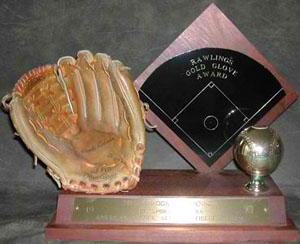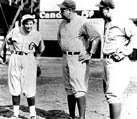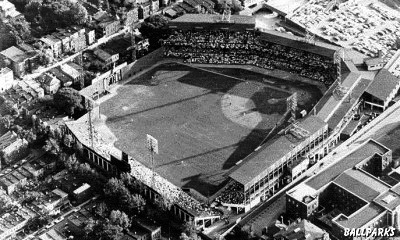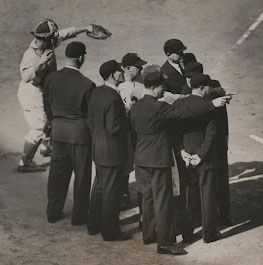CONTENTS
|
1910 saw the first baseball opener at which movies were made. This enabled fans at theaters across the country to watch President William Howard Taft inaugurate one of baseball's great traditions. Arising from an extra-large seat imported to contain his bulk, the president tossed the horsehide to Walter Johnson, the Senators' starting pitcher. It was a poor throw, but Johnson bent down and caught it. Then he hurled a one-hitter to defeat the Philadelphia Athletics 3-0. "Home Run" Baker fouled a ball off the head of Secretary of State Charles Bennett, who waved off assistance and assured spectators he was OK. |
 |
|
The first switch-hitter was Bob Ferguson. The interesting nickname "Death to Flying Things" has been mistakenly applied to him because, as an outfielder, he was supposedly known for his ability to catch fly balls in an era when players didn't wear gloves. However, further research reveals that the soubriquet actually belonged to Ferguson's teammate, Jack Chapman. Bob, an infielder, was known as "Old Fergy."
Ferguson scored the winning run for the Brooklyn Atlantics in 1870 to end the Cincinnati Red Stockings' record winning streak. Bob managed every team he played for from 1871-1884. Known for his bad temper, Ferguson became an umpire after his playing career. He is most famous in that role for breaking a batter's arm with a bat during an argument. |
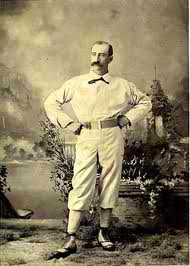 Bob Ferguson |
|
Some historians claim the first spring training was held in 1870 when the Cincinnati Red Stockings and Chicago White Stockings of the National Association held camps in New Orleans. The purpose was to find new prospects, help the veterans get into shape, and scrimmage local teams. The experiment did not catch on immediately, however. For the next twenty years, most teams trained in their hometowns simply because it was cheaper.
Cincinnati, in the midst of what would become an 84-game regular season winning streak, arrived in the Crescent City first and on April 25 began a week of play by defeating the local Pelicans 51-1. After two games in St. Louis, the White Stockings came to town several days later for five games. These games seem to have been treated as the first "match games" of the new season rather than a way to get the players into shape. The Chicago club also got its distinctive nickname when it unveiled its sharp new uniforms on their Southern trip. According to a Chicago Tribune article in May, 1870, "A bare-footed urchin in the crowd exclaimed: 'Oh, look at the White Stockings!' The boy's choice of an appellation has since been uniformly endorsed throughout the country." The White Stockings returned to New Orleans in March 1871 for a series of games. |
|
|
|
|
|
|
On July 31, 1935, Kitty Burke, a "nightclub entertainer" (ecdysiast?), was among the 30,000 spectators at Crosley Field in Cincinnati watching the Reds play the Cardinals. The sellout crowd filled the stands so that thousands of spectators, including Kitty, stood on the field in foul territory. Burke had been heckling batters all night.
In the eighth inning, with Babe Herman of the Reds in the on deck circle preparing to hit, Kitty grabbed his bat and stepped to the plate. To everyone’s amazement, P Paul "Daffy" Dean threw her a pitch, which she grounded to first. Cardinal manager Frankie Frisch argued that it should be the third out. However, the umpire disagreed, not counting her at bat as official since she was not on the roster. Herman then doubled as Cincinnati rallied for a 4-3 victory. Kitty Burke thus became the first and only female to ever attempt to bat in a Major League Baseball game. Allegedly, the Reds later gave her a uniform which she used while performing her act. |
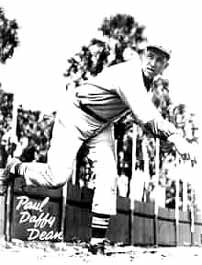 Paul "Daffy" Dean |
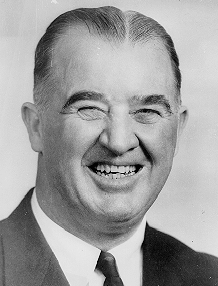 Happy Chandler |
The first time the lights were turned on for a World Series game was the fifth game of the 1949 World Series at Ebbets Field, Brooklyn. Commissioner Happy Chandler ordered the lights to be turned on at 4:50 pm as the contest entered the eighth inning. The October weather was sunny, but the shadows from the two-tiered grandstands covered the field.
Chandler had almost turned on the lights at Yankee Stadium during Game 6 of the 1947 Series. If the 3:19-long 8-6 Dodger victory had gone to extra innings, the commissioner would have illuminated the arcs. |
|
On June 19, 1889, William Hoy of the Washington Nationals of the National League became the first OF to throw out three runners at the plate in a single game. The feat occurred in a game against the Indianapolis Hoosiers.
Hoy was left deaf and mute from meningitis at the age of three. So he was called "Dummy" throughout his career. |
 |
|
Henry Chadwick first used the letter K to indicate a strikeout during the time starting in 1860 when he edited Beadle's Dime Base-Ball Player. Chadwick, an Englishman who emigrated to the U.S. in 1837, brought his love for cricket to this continent and became a cricket writer for the New York Times in the 1850s. He also fell in love with the cricket offshoot known as "base-ball" and made Beadle's publication the definitive guide for the new sport. He was also the first to tabulate hits, home runs and total bases, which led to such statistics as batting average and slugging percentage, although he wasn't directly responsible for their invention.
 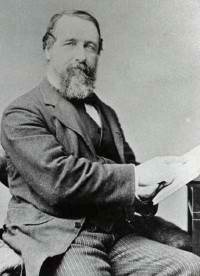 |
